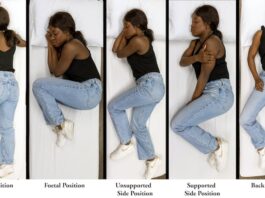
If you’re curious about how yoga may help you manage your knee pain, make sure to consult with your doctor first. Furthermore, find a yoga teacher or therapist who specializes in working with individuals with this condition.
A new study found that people with knee osteoarthritis who took a 12-week online yoga program experienced improvements in their physical ability—at least while they were completing the program.
After the yoga program ended, people’s interest in yoga and the benefits of the practice decreased. This was found in a study published on September 19 in the Annals of Internal Medicine.
The current study reveals that subjects who participated in the online yoga program did not experience any improvement in their pain symptoms. However, other studies have shown positive results.
Yoga can be quite useful for knee osteoarthritis, according to Pamela Stokes Eggleston, the creator of Yoga2Sleep in Maryland. She says that it can increase mobility and reduce the pain, which in turn, can lower the need for pain medication.
It’s not just that she is a yoga therapist, but she knows this as someone with knee osteoarthritis, said Eggleston.
When she felt pain in her knee joint, which is often the case for people with knee osteoarthritis, she said that “it wasn’t unbearable, but it hurt quite a bit and prompted me to have an X-ray and MRI.”
In her view, finding some relief from yoga medicine was not an issue. “What ‘medicine’ can I take from yoga to help me better?” she asked.
When the knee’s cartilage deteriorates, bones to rub against each other, causing pain and other symptoms.
It occurs more frequently in people 50 years of age and older, but younger people can also develop it.
People with knee osteoarthritis may be at increased risk of falling and developing balance problems as a result of weakened muscles supporting the joint.
Exercise is advised for those with knee osteoarthritis to reduce their pain, improve their physical function, and increase their quality of life because of this and other health risks.
People can also prevent the onset of joint disease and keep their weight under control by engaging in regular physical activity. The extra body weight can increase the knees’ level of stress and result in inflammation.
Active low-impact activities such as walking, biking, and yoga are gentler on the knees than high-impact activities such as running.
When asked about her exercise routine when suffering from knee osteoarthritis, Eggleston said walking has been and remains her “go-to” cardiovascular activity. She also does yoga daily and uses a rebounder, or mini-trampoline, for “any low-impact activity that would get my heart rate up,” she said.
In addition, she maintains a healthy weight and avoids added sugars by eating a mostly plant-based diet and limiting her caloric intake. However, any balanced diet should still be accompanied by a regular exercise regimen.
Recent research supports the use of yoga for knee osteoarthritis, improving pain, physical function, and joint stiffness, but none of these investigations focused specifically on online yoga programs for patients with this condition until now.
In this study, all participants had access to online information about osteoarthritis, treatment options, and the benefits of physical activity, weight loss, and healthy sleep habits. Of the 212 participants, 96 were randomly assigned to the healthy lifestyle group and 96 were assigned to the usual care group.
Researchers randomly assigned around half of the people to do a 12-week self-paced online yoga program.
Videos were recorded in a series of 12 and were each 30 minutes long. People were asked to make three videos a week.
A mix of static and dynamic yoga poses was designed to stretch and strengthen the muscles of the core and legs.
The program was built to be flexible and accommodating to different levels of ability and preference.
However, the classes focused solely on physical postures and excluded other aspects of yoga, such as deep relaxation, chanting, and meditation, that might also help reduce pain.
Compared to those who only had access to online osteoarthritis education, participants who did the yoga classes experienced greater improvements in physical function, knee stiffness, and quality of life after 12 weeks.
At 12 weeks, knee pain was experienced by both groups equally.
Researchers contacted the participants again after the program and found that both groups had the same amount of physical function, pain, knee stiffness, and quality of life one year later.
It is possible that many people stopped doing the yoga classes after the 12-week program ended, resulting in the loss of yoga’s benefits.
At the end of the course, over 66% of participants completed at least two classes a week. However, less than one-third were still doing the online yoga program regularly at the end of the follow-up period.
The authors explained that the yoga program failed to attract all participants, which might have diminished the realisation of any health benefits.
The true benefits of yoga for knee osteoarthritis may have been difficult to determine because of other factors.
The authors mention that “it is unknown whether the yoga elements were performed correctly or completely because the yoga program was unsupervised.”
We will send you treatment updates and pain management tips to help keep you motivated and moving.
Yoga for knee osteoarthritis should be taught by a yoga therapist or yoga teacher who specialises in yoga for arthritis. If you’re interested in trying yoga for the first time, look for a yoga specialist or yoga teacher.
In the new study, the “My Joint Yoga” program was created in collaboration with yoga therapists, a physical therapist, and people with knee osteoarthritis. The program is available online.
The poses taught in the course are the same as those found in typical yoga classes, with a variety of modifications and levels.
Eggleston said these poses strengthen the muscles around the knee, which is important for stabilizing the joint.
She has found that Chair Pose is particularly beneficial, but if you want to sit upright and avoid slouching, you can also lean your back against a wall for support.
For Eggleston, yoga is more than just lying on a mat and performing poses. “It is about being fully aware of what is happening in my body,” she explained.
Charlotte Nuessle, a yoga therapist in Massachusetts, said that yoga is about listening to and honouring the body’s signals. People with knee osteoarthritis should avoid pushing their knees until they experience pain, she said.
For those with knee osteoarthritis, sitting in kneeling positions with a folded blanket or pillow underneath the knees is a simple way to listen to your body, Nuessle claimed, “enough of a pad so that the knee doesn’t feel the weight of the body, especially on a hardwood floor.”
Holding certain poses, Nuessle advises people to avoid locking their knees. “When we lock out our joints, we are not asking our core to engage as deeply or with the same awareness,” she said.
It requires being able to activate the muscles of the core—more than just the abdominal muscles—and bringing this support to yoga poses.
Because “gentle mobilization and repetition” — known as “dynamic yoga poses” in Nuessle’s system — can also help people target muscles around the knee without injuring the joint, they are a great choice for those looking to boost their flexibility.
“Every time we repeat a movement, we have an opportunity to bring our awareness to it,” she said. “We have an opportunity to make a subtle adjustment. We have an opportunity to find a new way to do it.”
Online yoga may not be as effective at treating knee pain associated with osteoarthritis as conventional yoga, but it may provide some temporary relief, new research found.
While there is a lot of evidence supporting the idea that a consistent yoga practice can help people with knee osteoarthritis improve their pain, function, and stiffness, there are also a lot of anecdotal reports from teachers and practitioners supporting yoga for knee pain relief.
Make sure to speak to your physician if you are interested in how yoga may help you deal with your knee pain. It would also be wise to seek out a yoga instructor or therapist who has expertise in dealing with this type of problem.





